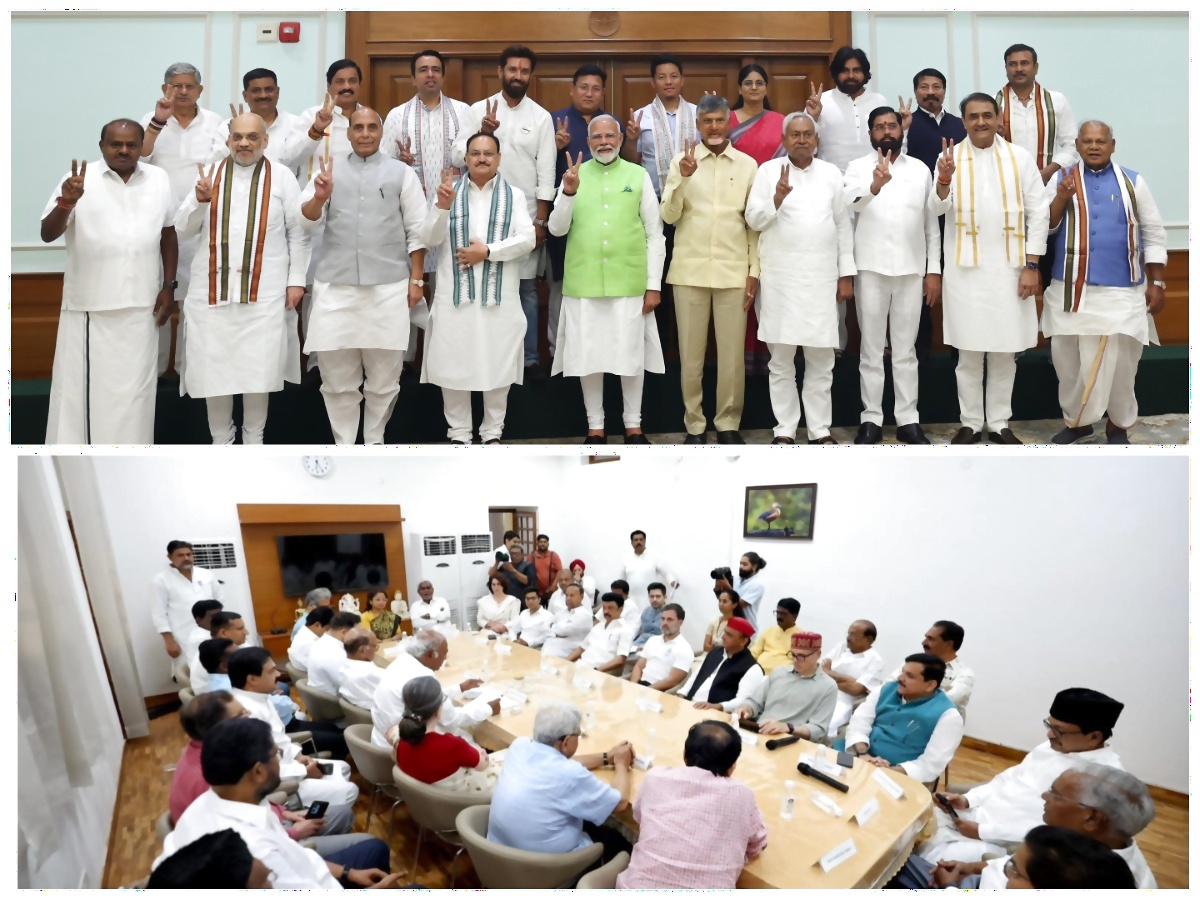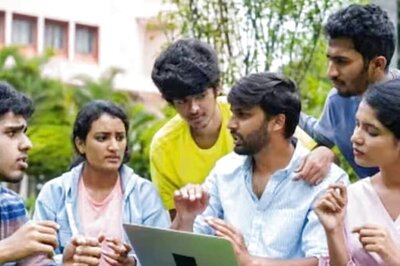
views
Prime Minister Narendra Modi is all set to form the government at the Centre for a third time under his leadership. He was unanimously elected as leader of the National Democratic Alliance (NDA) at a meeting on Wednesday. This will be followed by a parliamentary party meeting on June 7 where he will be elected as its leader. Next, Modi will take oath as the Prime Minister of India for the third time. This, in itself, will be a record in the name of Modi to whom political and electoral milestones are nothing new.
With that, the opposition INDIA bloc’s dream of there being obstacles in the path of Narendra Modi becoming the PM for the third time is also over. Bihar chief minister and NDA partner Nitish Kumar has appealed to Modi to form the government soon. The leaders of BJP allies have signed a letter electing Modi as the leader of NDA, paving the way for him to be back as PM.

And that opens the path to scripting history. Modi will be the first non-Congress leader to take oath as Prime Minister for a third consecutive term. He has also become the only person – apart from first Prime Minister Jawaharlal Nehru – in the history of independent India to have formed a government after winning three consecutive Lok Sabha elections under his leadership.
Not just that, he will also be only the third person since Independence to take oath as Prime Minister three times in a row. The other two on the list are Nehru and Indira Gandhi.
Indira Gandhi took oath as Prime Minister for the first time in 1966 after the demise of Lal Bahadur Shastri. Later, she took oath after the Lok Sabha polls of 1967 and again after the general elections held in March 1971.
As far as parliamentary and administrative records go, Modi stands out on many counts. He first took oath as a chief minister without contesting an assembly election. He became the chief minister of Gujarat on October 7, 2001, and held the post for close to thirteen years and then directly moved to the Prime Minister’s chair. Since the establishment of Gujarat in 1960, he has been the only CM to take the oath of office for four consecutive terms.
Modi, the longest-serving Gujarat CM, also set a record of winning three consecutive assembly elections for the BJP. This had never happened before. Now, he has repeated the feat at the Centre, managing to secure a victory in Lok Sabha elections for three consecutive terms leading the NDA and his party BJP. He is also the only non-Congress leader to do so.
For the Congress, Nehru accomplished this feat, but there’s a massive difference. Back in his time, the opposition in the first three elections after Independence was quite weak, unlike today.
Besides Nehru and Dr Manmohan Singh, Modi is the only Prime Minister who has completed two consecutive terms of five years. Indira Gandhi, who became the Prime Minister in 1967, opted for midterm elections even before the completion of her five-year term. The step to call snap elections in 1971 came after setbacks in the Privy Purse case, first in the Supreme Court and then in Parliament.
Apart from Nehru, in the Congress, only Manmohan Singh has the record of completing two five-year terms as the Prime Minister. Among the non-Congress leaders, only Modi has this record to his name. However, there’s a difference. While Modi became PM by himself winning the Lok Sabha elections twice with a full majority, Manmohan Singh led the country with the nod of Sonia Gandhi.
Manmohan Singh, who served two terms as the Prime Minister, was never the leader of the House in the Lok Sabha because he did not contest the Lok Sabha polls. He could not muster the courage to come to the Lok Sabha by being elected directly by the public and came to Parliament through the Rajya Sabha route. If we talk about serving two consecutive full terms along with being the leader of the House in the Lok Sabha, then it’s just Modi after Nehru.
Modi though trumps Nehru in one aspect. Before becoming the Prime Minister, Nehru had only been the head of a municipality in Allahabad, his only administrative experience. In contrast, Modi became the Prime Minister of the country on May 26, 2014, after being the chief minister of Gujarat for almost 13 years. During his record tenure as the CM, the country and the world appreciated his administrative abilities, further strengthening his credibility. That brought him to power in 2014 with a big mandate.
He is the only person in the political history of this country to have transitioned from the CM’s chair after about 13 years directly to the Prime Minister’s office without taking a break. He is now all set to start his third term after being the Prime Minister for 10 years continuously. That means, he has been continuously holding top administrative posts like CM and PM for almost 23 years.
As far as electoral politics and victories are concerned, Modi has registered an unprecedented record there as well, unlike anything in the past and probably the future. Modi, who won three consecutive assembly elections in Gujarat as CM, has also scored a hat-trick in the Lok Sabha elections and brought victories to the NDA.
As far as the BJP is concerned, Modi has created a unique record there too. Under the leadership of Modi, the BJP, in its 44-year history, has achieved its three biggest victories in the Lok Sabha elections.
The BJP was founded in 1980 and contested its first Lok Sabha elections in 1984 when it secured only two seats. This was the election where the Congress rode a wave of sympathy following the assassination of then Prime Minister Indira Gandhi and was successful in winning more than 400 seats for the first and last time in the parliamentary history of the country.
The Congress had won 404 seats in the 1984 Lok Sabha elections. It was because of the wave of sympathy due to which the Congress achieved a historic victory that BJP leader LK Advani had termed it “Shoksabha elections”.
The BJP, which won only two seats in 1984, has got the opportunity to win more than 300 seats only once in its history. Under the leadership of PM Modi, the party won 303 seats in 2019. Before this, the BJP’s best performance in the Lok Sabha polls was in 2014, when once again under the leadership of Modi, the party got 282 seats and formed the government at the Centre on its own for the first time.
Earlier, the BJP government, which was formed under the leadership of Atal Bihari Vajpayee in 1996, 1998, and 1999, was dependent on NDA allies. In the 1996 Lok Sabha elections, the BJP had won 161 seats and in 1998 and 1999, it had won 182 seats both times.
As far as victory in the 2024 Lok Sabha elections is concerned, the BJP has got 240 seats and NDA has received 292 seats, which is well above the 272 required for a majority in the House. This victory of 2024 is the third biggest in the BJP’s history and this record is also under Narendra Modi’s leadership.
During PM Modi’s 10-year tenure, the BJP spread its wings across the country. In the last 10 years, the BJP has formed governments in many states and won more seats than ever before. The party has been able to open its account in Kerala in 2024 with its win in the Thrissur Lok Sabha seat.
As PM Modi begins his third term, his focus will be on making India the third-largest economy in the world after making it the fifth-largest. Modi, who is going to run the government with the support of NDA allies, has already set his priorities: there will be no laxity in the fight against corruption nor in major economic reforms.
During NDA’s meeting, allies have praised PM Modi’s resolve and vision of a ‘Viksit Bharat’, and lauded his efforts to alleviate poverty.
After 60 long years, a PM is going to form the government for the third consecutive time after winning the elections. Modi is the second person after Nehru to get this opportunity. Modi will also have his sights set on some other milestones, to create new history and new records on all fronts – political, diplomatic, administrative, and electoral.
By the way, the Congress too has also inadvertently created a new record because of Modi. That record is of staying out of power at the Centre for the longest time. Before the Modi era, the Congress had been out of power for a maximum of eight years, between 1996 and 2004. Now, it has been waiting for the past 10 years and its leaders are not sure when this period will end.
As long as Modi continues his streak, not only Congress but other opposition parties too will end up creating records of waiting to return to power. It has been 35 years since someone from the Nehru-Gandhi family became the Prime Minister, and Modi is going to lengthen this period further. Just keep an eye on his new records.














Comments
0 comment